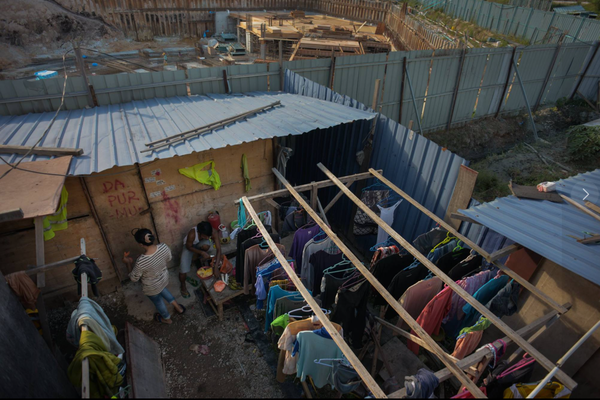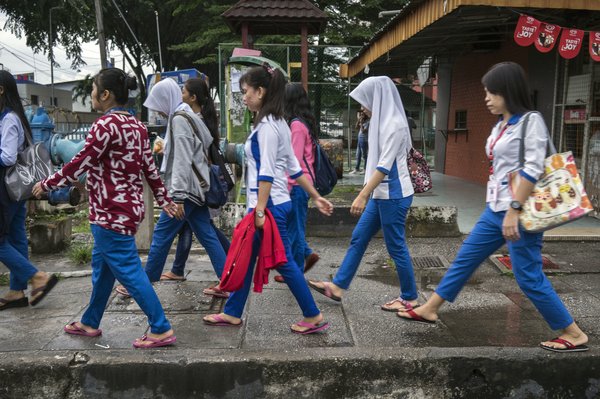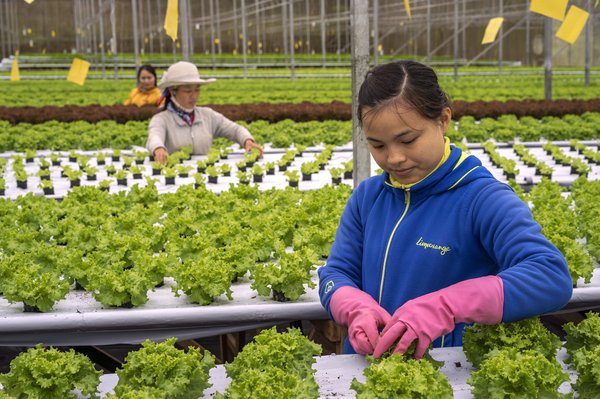
A construction worker is finishing sealing glass at a building construction site in Kuala Lumpur. Photo: Trinn Suwannapha / World Bank
This blog was written by Dr Andika Ab.Wahab, Corridor Advisory Board member for MIDEQ's Malaysia team and Fellow, Institute of Malaysian & International Studies (IKMAS), National University of Malaysia (UKM).
Introduction
Malaysia reported its first COVID-19 case on 25 January 2020. By the end of the year, there were 113,010 confirmed COVID-19 infections in the country. Throughout the year, media reports revealed the poor working and living conditions of migrant workers with the discovery of several COVID-19 clusters among them.
From June to December 2020, the government implemented the Movement Control Order (MCO) as a response to preventing the spread of the virus. During different phases of MCO, I managed to interview some Indonesian, Bangladeshi and Nepali workers about their current plight. Hearing many of them repeatedly say they “regret” coming to Malaysia raises questions on the future of work migration in Malaysia.
Migrant workers in Malaysia
For decades, Malaysia has been dependent on low-wage foreign labour in six key sectors of the economy. Current estimates indicate between two and five million of migrant workers in Malaysia, including those without a valid working pass. Experts observed that without migrant workers, industries and businesses will suffer badly.
It is well known that international migration helps in mitigating poverty in the sending countries. In 2019, remittances from migrant workers globally valued at US$714 billion benefited around 800 million recipients in source countries. Remittances do not only promote economic growth in the source countries but also alleviate the credit constraints on the poor in the areas of their children’s education, access to healthcare, and daily livelihood.
The prospect of receiving comparatively high income in the destination countries has been the key motivation for international mobility. Other factors such as the role of intermediaries, costs of migration, social networks, and immigration policies also influence the aspiring migrant workers’ decision-making process. For many Indonesian and Bangladeshi workers, Malaysia’s porous land and maritime borders is a key reason for choosing irregular routes into the country.
COVID-19 and the plight of migrant workers in Malaysia
Prior to the COVID-19 pandemic, many migrant workers in Malaysia were already living in overcrowded and unhygienic accommodation. In the construction sector, for instance, it was not uncommon for them to be accommodated in converted containers with poor access to clean water and basic sanitary facilities.
One Bangladeshi construction worker in Kuala Lumpur said to me:
“I live together with other 12 Bangladeshi and Indonesian workers in the same shared cabin, about 15 feet x 10 feet. There is a shared kitchen and toilet outside the cabin. There were no proper cooking facilities. We shared everything including glasses and plates, and there was no proper piping system to get clean water. At night, we slept very close to one another. It was impossible to mind the distance”.
Some workers also reported having to work long hours, often in conditions of high temperatures and poor ventilation, thus putting them at greater risk of occupational injury and getting infected.
In many other cases, foreign migrant workers could not work during the lockdown. The Malaysian Human Rights Commission reported that many workers had not receive any communication from their employers since March 2020. Moreover, for those whose work permits were close to expiring, they were left in the dark about their employment status.
A Nepali worker I interviewed in September 2020 said to me: “Living through this period is so different and full of uncertainty.” He did not see the benefit of migration anymore. Prior to the COVID-19 pandemic, he used to remit between US$300 and US$400 a month back to his family. Employed for two days in a week as a kitchen assistant in a food chain restaurant, due to the government’s strict standard operating procedure (SOP) , he could now earn between US$150 and US$200 a month, sufficient only to sustain his expenses in Malaysia with nothing left for his family.
Similarly, an Indonesian worker expressed deep regret for having to come to Malaysia. He had originally planned to work in South Korea or Japan where the income is higher than Malaysia. But because he was cheated by a recruitment agent in Sulawesi, he had to turn to his second choice of coming to Malaysia.
For him, the pandemic has revealed to him the country’s lack of protection and sympathy for migrant workers. He said:
“We are the backbone of this country’s economy. We do all the work that the locals don’t want to do. Employers rely on us. But why are we the first to be sacrificed during this time?”
These stories of discrimination and neglect point to two interrelated questions: what will the future migrant workers landscape in Malaysia look like? How will this in turn affect Malaysia’s economy in the post COVID-19 recovery era?
I believe that the experiences and perceptions of being discriminated against are being shared widely by current migrant workers with their relatives and friends in their respective villages and home country. This will influence prospective and aspiring migrant workers’ views towards Malaysia as the preferred country of destination.
At the other end of the migration chain, employers and business associations in Malaysia have already raised serious concerns on growing labour shortages in key sectors important for the national economy. The espoused national vision to gradually replace its heavy dependence on foreign migrant workers with local labour, and moving towards mechanization is an old mantra. It was promoted as early as the 1990s when the government first introduced a levy system. However, after nearly three decades, the number of migrant workers in Malaysia has increased exponentially, while industry players have not fully embraced mechanization.
The hiring of migrant workers has long been considered as a temporary and short-term measure in filling up labour gaps in Malaysia. Because of this perspective, the contribution of migrant workers has been belittled, and many even believe that they deserve less protection compared to the local workforce. As Malaysia reopens the economy in the post-COVID-19 era, it is high time to reorient migrant workers' position in labour market with a view to optimize their contribution and uphold their rights as workers.



